Soldering tips types and applications
Tips are vital, consumable parts of soldering irons and stations. Choosing the right model is not as easy as you may think, as even the smallest differences in the tip shape and size can substantially affect the efficiency and comfort of work.
In this article, we will offer you a closer look at various aspects related to soldering tips and describe how to choose suitable tips for your application. It is important to note at the very beginning that such a choice is primarily dictated by the type of soldering equipment and user’s individual preference. Still, there is more to it than those two factors, as sometimes it’s the other way around and it is the choice of the soldering iron model that is determined by the device’s compatibility with tips that have some specific and needed features. Let us take a look at the options available on the market and their key features.
In this article, you will find a lot of information about soldering:
- Basic information about soldering tips
- Soldering tips with built-in heaters
- Quick tip replacement in soldering stations
- Different shapes of soldering tips and their applications
- Advantages of compact gas soldering irons
- The right accessories for transformer soldering irons
- Soldering tips for the soldering and desoldering of SMD components
- Nozzles for hot-air stations and soldering tips for desoldering
Material, design and mounting
First of all, it is important to emphasise that there is no universal global standard for soldering tip sockets. Almost every manufacturer develops its own solution. An exception here are suppliers that make ‘budget’ devices, in which they employ modular structures, as their products may prove to be compatible with solutions from other manufacturers. When it comes to specialist brands, there are two common ways of inserting a soldering tip into a socket:
- with the use of a compression ring (in that case, the tip most often has a collar);
- with the use of a tightening screw.
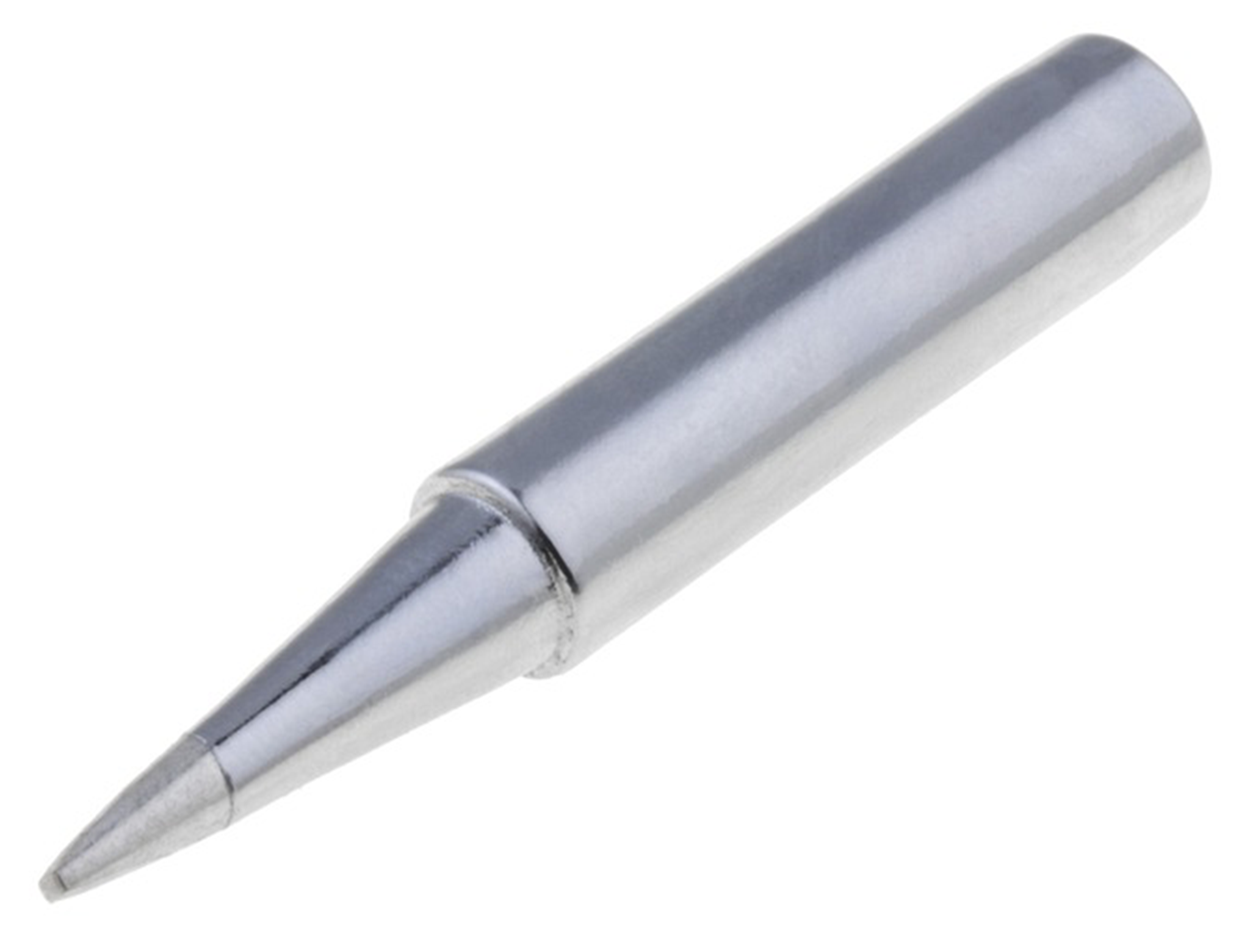
AT-SS-T-1.2D The most basic conical tip with a characteristic end.
Proper installation of a tip is crucial for a soldering iron to work properly, as it has to ensure the best possible thermal conductivity between the heater embedded in the flask (or its mandrel) and the tip itself. The best solution here would be to use a thread. However, the thread would become seized under the influence of repetitive and extreme temperature changes. That is why manufacturers opt for intermediate solutions, such as using non-replaceable compression elements.
Soldering tips are made of copper-based alloys, which give the component relative thermal conductivity. The tip ends most often undergo machining and galvanisation, which is why they should be cleaned only with the use of appropriate materials, usually sponges or tip cleaners made of soft metal chips. Using other ‘DIY’ methods (abrasives, acids) is very likely to damage the tip and make it very hard to use, especially in the tasks that require precision.
In order to select a tip that is compatible with a particular model of a soldering iron or soldering station, you should first view the manufacturer’s technical documentation (provided by the distributor). In the case of the TME catalogue, you can find a list of compatible soldering tips in the ‘RELATED PRODUCTS’ section on the page of each soldering device.
Soldering tips with built-in heaters
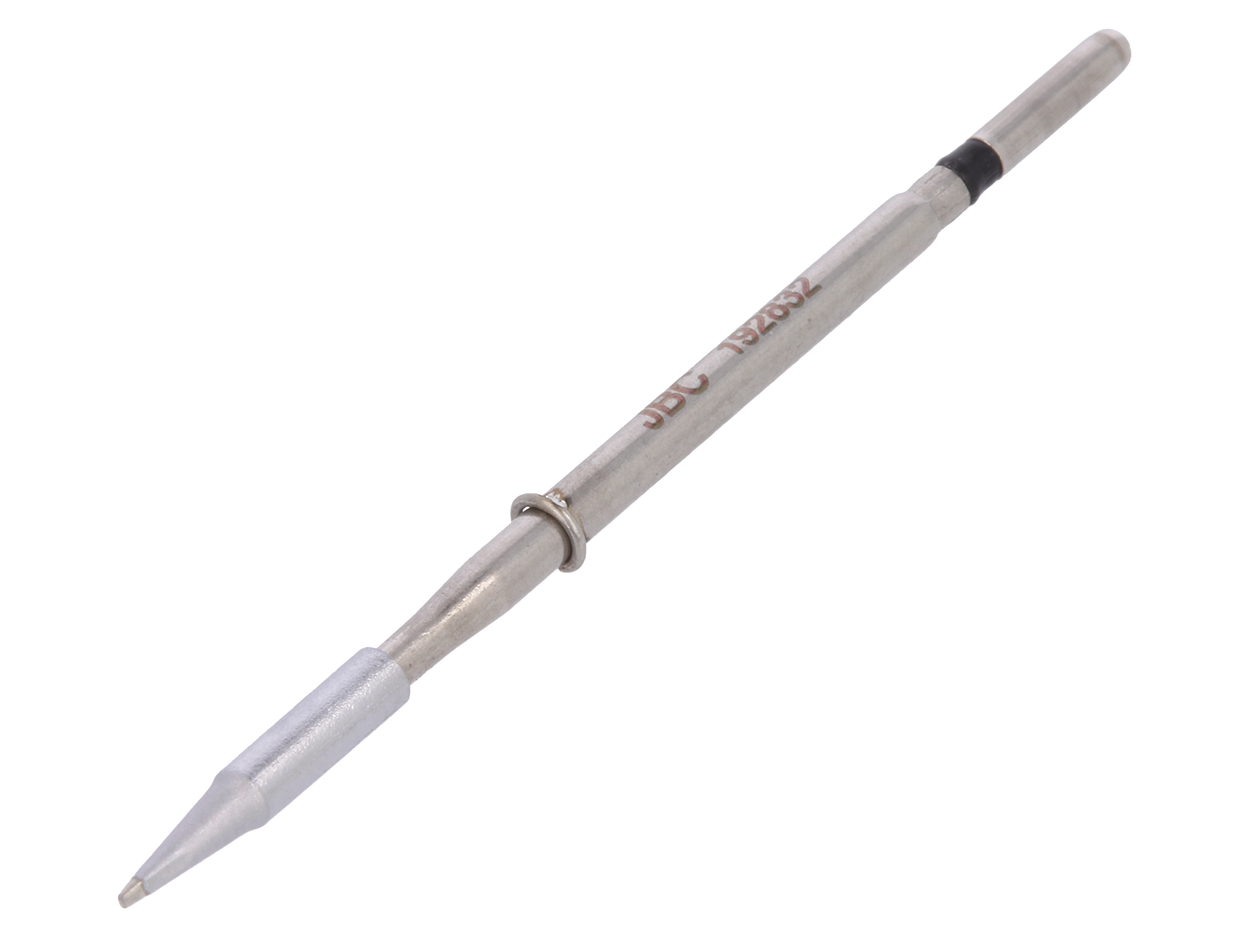
JBC-C105117
The JBC-C105XXX series of soldering tips can be used with the JBC-NANE-2C and JBC-NASE-2C soldering stations.
The tips are divided mainly depending on the design of a soldering iron or station itself. As it was mentioned above, there is no generally accepted standard of sockets for soldering tips. Manufacturers come up with their own ideas, one of them being a socket which transfers voltage to the tip. While a ‘classic’ tip is a block of metal which conducts heat from the heating element to the solder, the more advanced design involves installing the heater (as well as the thermocouple) in the same module as the tip. This solution is employed primarily in advanced and precise devices, for example the ones offered by JBC or Weller. It has several significant advantages, but perhaps the most important one is low energy loss, which is possible thanks to the connection that ensures very good thermal conductivity (and that additionally results in the tip heating faster and the controller reading its temperature more accurately).
Such a design results in a longer service life of the soldering iron, as both of the components that are the most prone to wear (i.e. the tip and the heater) can be replaced easily. However, the price of the accessories is a big downside to this solution and the main reason why soldering stations and irons that require the use of a tip connected to the heating element are used mainly by professional factories and laboratories.
Quick tip replacement systems
In professional settings, such as production lines or extensive service work, the operator often needs two or even three different soldering tips to complete a task. That’s why many manufacturers of professional equipment employ a quick tip replacement system in their soldering stations. Replacing the tips is not a technologically complicated task and it can be done with one hand. The tips are stored in a special tip holder. An old tip is removed by hooking the blade in the slot and lifting the flask, and a new tip is then pushed into the same slot. This system is used mainly in devices using tips with a built-in heater (mentioned above), where the installation and removal of the tip shouldn’t require too much force.
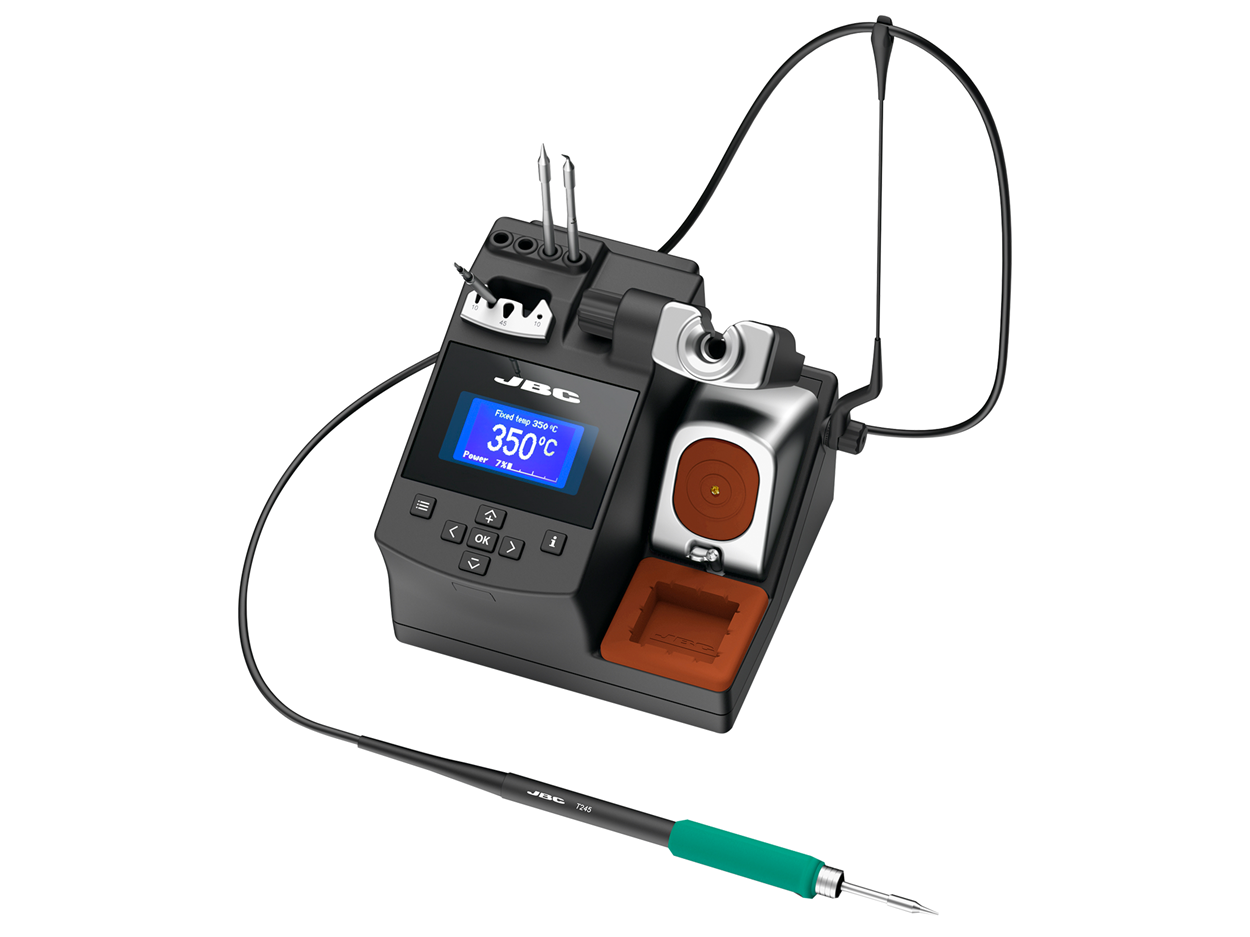
JBC-CD-2BQF
The plate visible above the display is the tip replacer
Shapes of soldering tips
Choosing the tip shape is largely dictated by the individual preferences of the user. Leaving aside the question of size, which remains dependent on the type of a circuit to be soldered, a beginner technician should try out several solutions available on the market in order to select (through practice) the tool that best suits their working method. Regardless of which soldering iron or station they use, they will almost always have a choice of four basic tip shapes :
AT-SS-T-3C_QUICK-Q-T-3.2D_AT-SS-T-B_QUICK-Q200-SK
The most popular tip shapes are: conical, chisel, miniwave and knife.
Miniwave
Miniwave is characterised by a concave bevel at the end of the conical tip. This causes surface tension to hold a drop of solder at the very end of the heated tip. Thanks to that, convenient surface mounting of ICs, especially those with a large number of leads is possible. The component is mounted by sliding the tip across its outlets this requires some skill, but makes it possible to achieve satisfactory results quickly, even without the use of a hot-air station.
Chisel
It is a tip with an oblong and flattened end, resembling the tip of a flathead screwdriver. With its use, it is easy to mount and dismount threaded components and spread the solder over the surface. Chisel tips are great for heating braided copper strands, which are used to remove binder (or its excess) from PCBs. The large, linear contact area between the tip and the circuit surface facilitates even heating of large surfaces and blocks, which is why this type of a tip is also used in the so-called ‘tinning’ of wire conductors.
Conical
Conical tip is considered to be the most universal type of a tip and it is very often included in soldering iron sets. It is characterised by a rounded end, which is suitable for all types of components, and it can be used for tasks that require accuracy. The most precise models of conical tips (a fraction of a millimetre in diameter) are perfect for working with SMD circuits, especially when correcting and adjusting connections, where it is required to heat the leads of an IC or connector only selectively. Tips with larger diameters have the widest range of applications and can be used for virtually all basic soldering work (in the field of electronics).
Knife
Knife is a tip that combines the advantages of a chisel tip and a precise end if the user frequently assembles and disassembles SMD components, this may prove to be the best solution for this type of work. Nevertheless, as it has already been mentioned, it is a matter of individual preference.
Less common solutions
The list above includes the most important information on the subject of soldering tips, but there are still a few less common and rarely used options that should be mentioned, e.g. solutions for devices used in other soldering technologies.
Tips for gas soldering irons
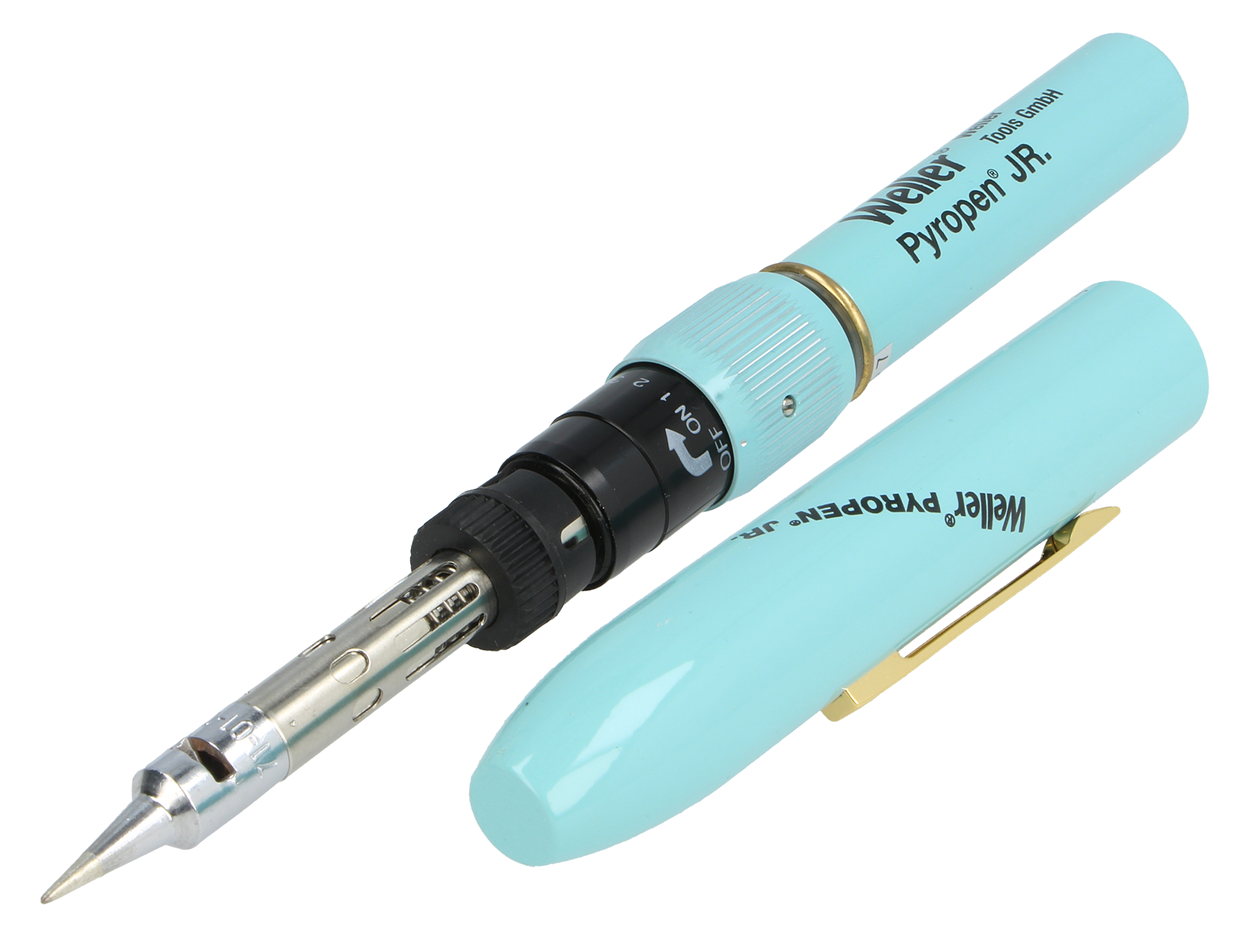
WEL.PYROPEN-JUNIOR
Weller gas soldering iron with a characteristic ‘hollow’ tip.
Gas soldering irons are often associated with large devices used for connecting copper pipes or gutters (although special torches are usually used for these applications). The reality is quite different, though. In fact, gas power is the optimal solution for small and portable devices, as a small tank holds enough fuel to do a lot of soldering work. Similar small devices powered by lithium-ion cells are also available on the market, but their efficiency is slightly lower.
Most tips for gas soldering irons have gaps for exhausting fumes, often additionally protected with a mesh to make sure that the ventilation channel does not get obstructed. An alternative are tips which are fixed around the nozzle, similarly to torches. The ignited gas jet strikes directly at the back of the tip, so the workpiece gets heated very quickly. For standard tips, it will be a few seconds. However, at this point it should also be noted that an additional advantage of gas soldering irons (even of those with a compact design) is the possibility to use a tip with a relatively large surface area, not only for soldering, but also, for example, for cutting plastics. Torches, on the other hand, can be used to weld materials, burn old coatings, but also with heat-shrink materials.
Transformer soldering iron tips
Although transformer soldering irons are among the least common solutions these days, they haven’t gone out of use. This is most likely due to the fact that they have at least two advantages over other types of soldering irons, namely, their extremely short heating time and a very low price of soldering tips. In practice, that means that in transformer soldering irons any wire (but usually a copper one) with a cross-section that can conduct high currents can be used as a tip. However, proper operation of the device requires the use of a dedicated tip with certain properties (resistance, mass, surface coverage). Electronic parts distributors, including of course TME, still offer a selection of soldering tips for transformer soldering irons, some of which are designed for work with modern precision electronics circuits, as they have bevelled, conical or other special types of endings.
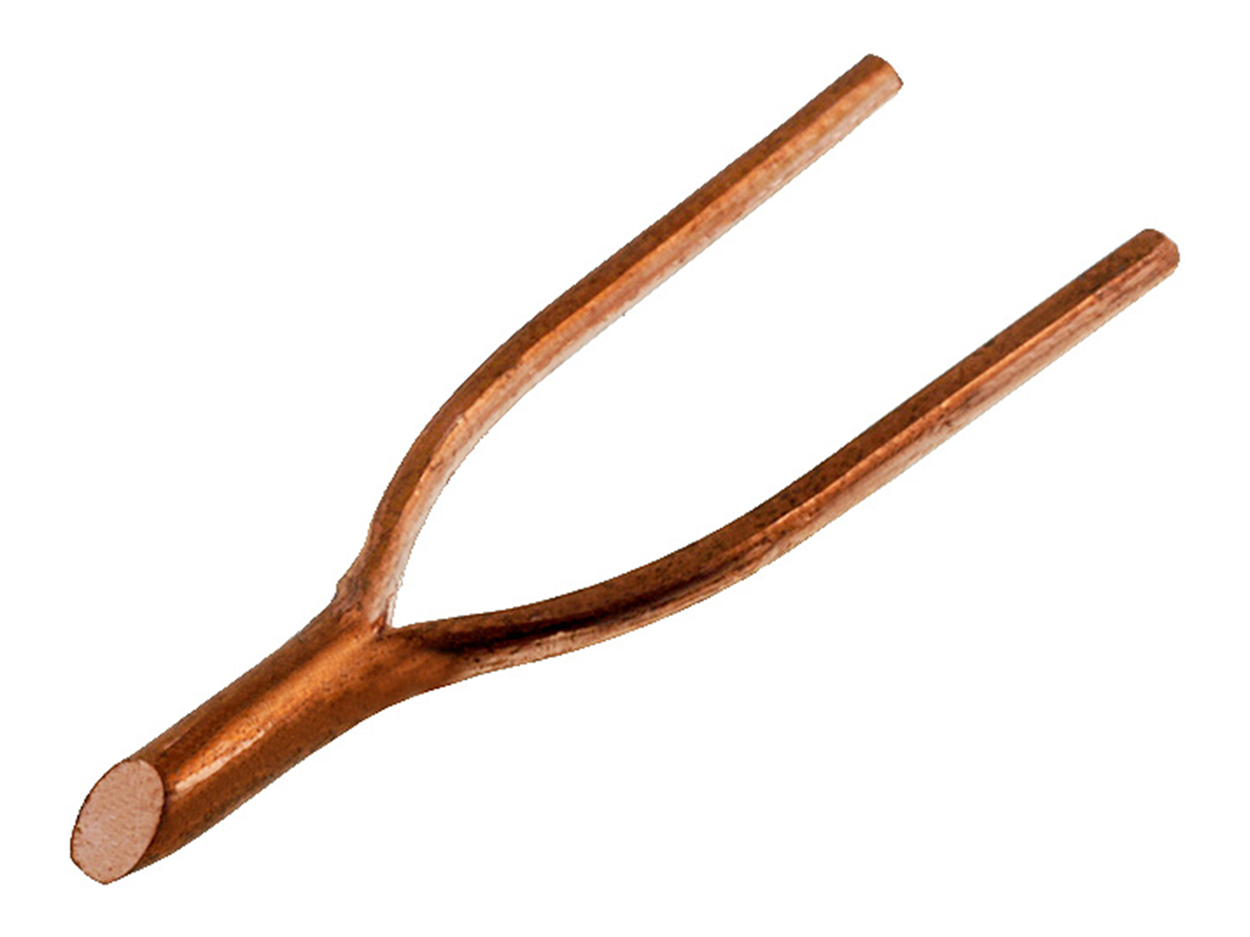
LT-L
Bevelled tip for a transformer soldering iron.
Micro tweezers
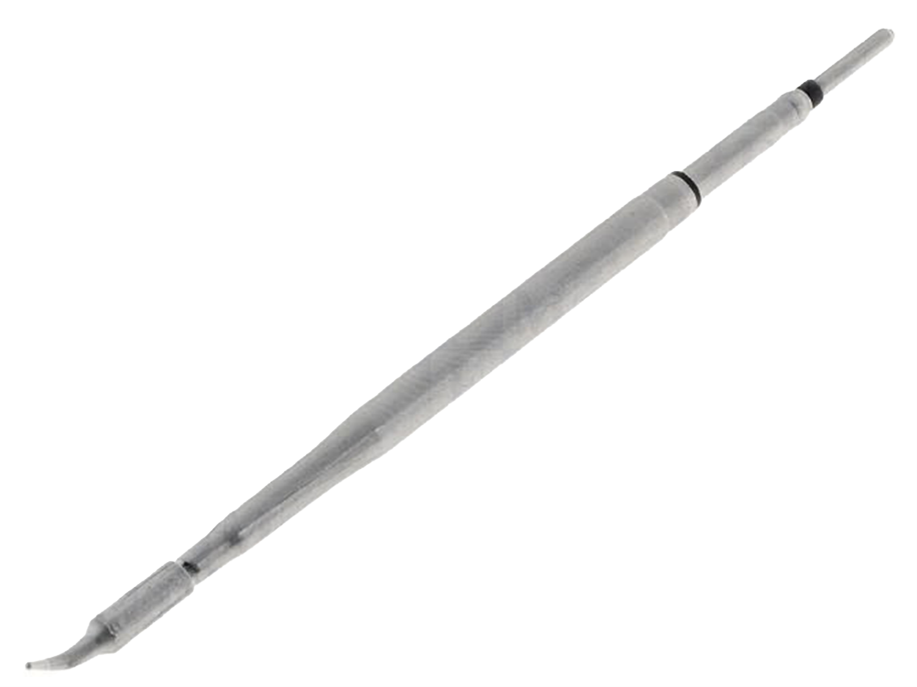 JBC-C120902 JBC tips.
JBC-C120902 JBC tips.
The popularity of surface mount devices (SMDs) has created the need to develop a new technique for hand soldering and desoldering of components. They are very small elements, which are often densely packed on the PCB. This is due to the fact that, in most cases, they are machine-mounted. However, service works are still most often performed manually, and sometimes, to make them easier, special micro tweezers, whose jaws are a pair of hot soldering tips, are used. They make disassembling a small resistor or capacitor a very simple task. They also make handling and soldering components easier. As you might have guessed, tips for such tweezers often (although not always) come as a pair. They are often characterised by a bent ending, which facilitates grasping.
Nozzles for desoldering and hot-air soldering irons
Nozzles are not the subject of this article, but in order to exhaust the topic discussed here, it is necessary to mention two other product groups. The first one includes tips for desoldering irons. Their purpose is to heat the solder up to its melting point (but also to provide a channel through which the solder gets sucked by means of a vacuum pump). Such elements are used both in professional service stations and affordable desoldering irons, where the function of the pump is performed by a spring-driven mechanism. As for the other group, hot-air soldering nozzles, they come in both universal (from large diameter to very precise) and specialist versions, sometimes designed for just a single format of ICs.
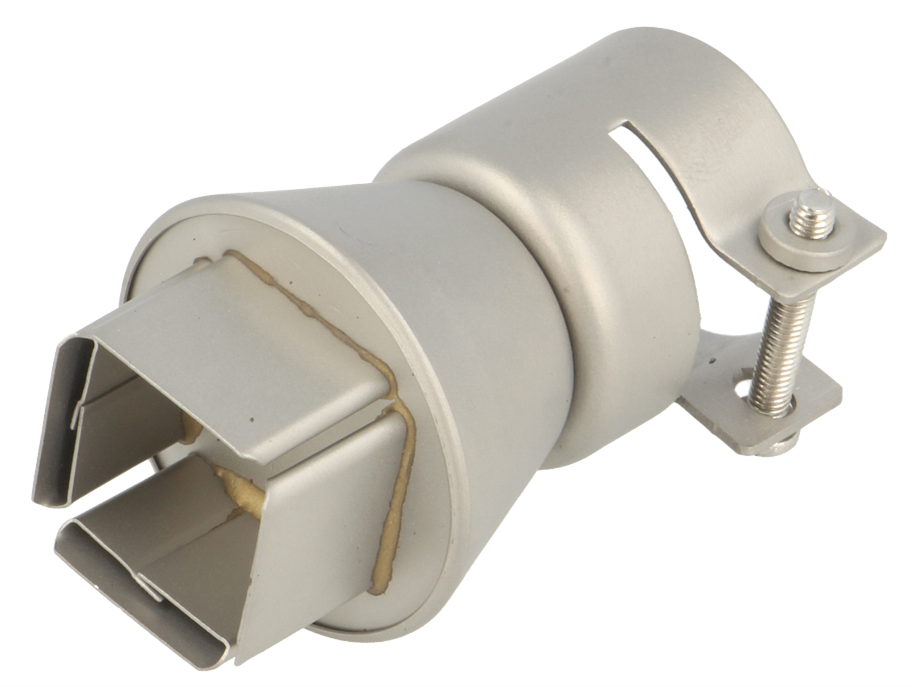
HTN-QF80
Nozzle face designed for mounting/dismounting circuits in QFP enclosures.










